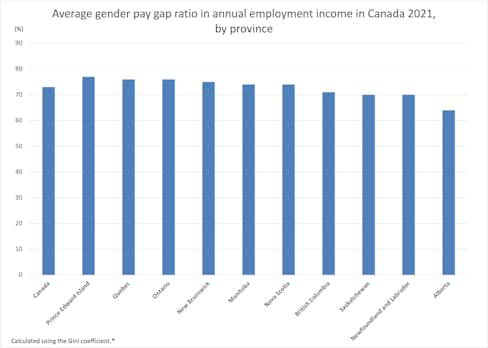
In Canada, federal pay equity legislation applies to most public sector employers. But some provinces have pay equity laws extending to the private sector as well, and some have also implemented pay transparency legislation. This article gives an overview of these pay equity and pay transparency requirements in Canada and its provinces.
In May 2024 we published an e-book on The federal pay equity act and pay transparency laws in Canada. It is available to download for free and provides information on how the landscape of pay equity and pay transparency in Canada has evolved in recent years.

This article is a big-picture guide to help you navigate the changing landscape of pay equity laws and pay transparency laws in Canada. It gives an overview of both the federal and the provincial legislation that may apply to your organization.
Pay equity and pay transparency laws in Canada have evolved a lot in the last fifty years. The framework we know today is based on the Canadian Human Rights Act, the first federal anti-discrimination law in Canada, passed in 1977, which gave some recourse for pay discrimination.
However, the Act was based on complaints, so it put the onus on employees to report pay discrimination rather than on employers to proactively prevent it. In the late 2010s, the government began to develop legislation that would move pay equity in a new direction and eventually supersede the Human Rights Act. This resulted in the Pay Equity Act, which was passed in 2018 and came into effect in 2021. It established a proactive approach to pay equity rather than one based on complaints from employees. The responsibility is now on the employers.
One limitation of the federal regulations—both the Pay Equity Act and the preceding Human Rights Act—is that they were written to apply to only federally regulated industries in Canada. (This includes banking, communications, and transportation companies as well as government departments and institutions.) So some provinces (like Ontario and Québec) created legislation that applies to public sector employers as well.
Provinces have also identified other ways to reduce pay discrimination and pay inequality. Some implemented or developed their own specific pay equity laws. Others broadened their focus to pay transparency.
The figure below shows the (unadjusted) gender pay gap ratio by province. Nationwide and on average, there is a substantial pay gap in Canada: female employees only make 73% of what male employees make.

Canada’s federal Pay Equity Act applies to federally regulated employers with 10 or more employees, including:
Under the Act, covered employers are required to conduct periodic evaluations for pay inequality in jobs commonly held by women. In other words, these organizations need to actively examine their pay practices to ensure that there is comparable pay for work of equal value across genders. This involves comparing traditionally female-dominated job roles (customer service, for example) to traditionally male-dominated ones (like maintenance).
Employers of a certain size are required to form a pay equity committee, and all covered employers must develop a pay equity plan. This plan involves:

The federal Pay Equity Act applies to covered employers in Alberta, but there are no pay equity or pay transparency laws at the provincial level.
The federal Pay Equity Act applies to covered employers in BC.
In addition, the province has instituted its own Pay Transparency Act, which was passed in May of 2023. Initially, this law will apply only to government employers, but it will incrementally expand to all employers with 1,000 or more employees, then 300 or more employees, then 50 or more employees.
This legislation aims to reduce systemic discrimination in the workplace by:
The federal Pay Equity Act applies to covered employers in Manitoba. The province also has its own Pay Equity Act that applies only to the public sector. This legislation mandates wage parity across genders between employees with functions "of equal or similar worth.” It also addresses negotiations with public sector employee unions.
A provincial Pay Transparency Act is in the works for Manitoba. As of early November 2023, a draft of this law has been introduced to the legislature twice, but it has yet to be passed.
The federal Pay Equity Act applies to covered employers in New Brunswick. Similar to Manitoba, New Brunswick has its own Pay Equity Act that stipulates equal pay for equal work in the public sector. This legislation took effect in 2010.
New Brunswick does not currently have any provincial pay transparency laws.
The federal Pay Equity Act applies to covered employers in Newfoundland and Labrador. The provincial government has also developed its own pay equity and pay transparency legislation, ratified in October 2022.
The pay equity component of this law will apply to public sector employers. Specific requirements are still under development, but will likely involve job valuation and reporting.
The pay transparency aspect of this bill applies to both public and private sectors. The specifics are also still under development but will likely tackle pay discrimination by:
The federal Pay Equity Act applies to covered employers in Nova Scotia. The province also passed its own Pay Equity Act way back in 1988. This law mandates equal pay in the public sector only.
At around the same time, the province implemented its Labour Standards Code, which addresses pay transparency. The key actions of this legislation are:
Note that in Nova Scotia, the pay transparency regulations do not mandate pay ranges in public job postings.
The federal Pay Equity Act applies to covered employers in Ontario. To move closer to ensuring work of equal pay for work of equal value throughout its workforce, Ontario has also passed its own pay equity legislation. These measures extend equal pay for equal work requirements to private sector employers.
In addition, Ontario’s Pay Transparency Act was passed in 2018 but has not yet taken effect. This law will eventually:
The federal Pay Equity Act applies to covered employers in PEI. Similar to Nova Scotia, PEI made moves to combat pay inequity in the late 1980s. However, its provincial Pay Equity Act applies to private sector employers as well as public sector. This legislation:
In 2021, PEI passed provincial pay transparency legislation in the form of amendments to its Employment Standards Act. This legislation:
The federal Pay Equity Act applies to covered employers in Québec. The province also implemented its own Pay Equity Act in 1996, which extended pay equity requirements to both public and private sector employers with 10 or more employees. Due to an initial lack of compliance, the provincial government strengthened this legislation in 2009. It now requires employers to:
Québec does not currently have any province-specific pay transparency laws.
The federal Pay Equity Act applies to covered employers in Saskatchewan, but there are no pay equity or pay transparency laws at the provincial level.
Canada’s federal Pay Equity Act actually does not apply in the Northwest Territories, Nunavut, or the Yukon. These territories also do not currently have their own pay transparency legislation.
As we’ve seen, pay equity requirements and pay transparency requirements in Canada vary greatly among the nation’s provinces and territories. Fortunately, PayAnalytics is a holistic solution that provides powerful, customizable tools that can help you satisfy all the applicable federal and local requirements.
Our job evaluation feature is designed to help you set a value for all of your job classes by applying objective, gender-neutral criteria. You can use PayAnalytics’ compensation mapping to compare your employees’ pay. If you do find any pay disparities, this feature also calculates corrective raises that are as budget-friendly as possible.
We also maintain a growing library of written resources, like our local requirements page, which outlines legislation in Canada and around the world. You might also want to keep an eye out for news about our upcoming e-book, which will go into a little more depth on Canada’s federal and local pay equity and pay transparency laws.
In the meantime, you can book a 1:1 with one of our pay equity specialists to get started on your journey toward pay equity and pay transparency.
The information on this page is not intended to serve and does not serve as legal advice. All of the content, information, and material in this article are only for general informational use. Readers are advised that this information, legal or otherwise, may not be up-to-date.
At PayAnalytics we write in-depth articles and guides on all things pay equity, DEI, and workforce analytics. Visit our resources page for the full overview. In our newsroom you can find the latest news on the company and related content.

How to transpose the EU pay transparency directive into national law? A team of experts, including our own Margrét Bjarnadóttir, provide guidance on how nations might balance effectiveness and ease.

Three years ago, the watchmaker Breitling conducted fair pay analysis for its largest employee population, based in Switzerland. The results gave them an appetite to do more, so they began a global analysis across dozens of markets. Rewards and performance lead Nadja Sirotkina tells Henrike about the lessons the company has learned.

Pay equity falls under the “S” in corporate social responsibility (CSR) and environmental, social and governance (ESG). In Part 1 of this two-part blog, we talked about some best practices for talking about pay equity in CSR/ESG reports and other external communications. Now in Part 2, we’ll focus on some great real-life examples that we can learn from.
Our newsletter covers topics like pay equity, compensation & benefits, DEI (diversity, equity and inclusion) and legislation changes as well as news on our company and software updates.


This website uses cookies to collect usage data, allowing us to improve your user experience, serve personalized ads on other networks and filtering out traffic from bots. To find out more, read our privacy policy and cookie policy.